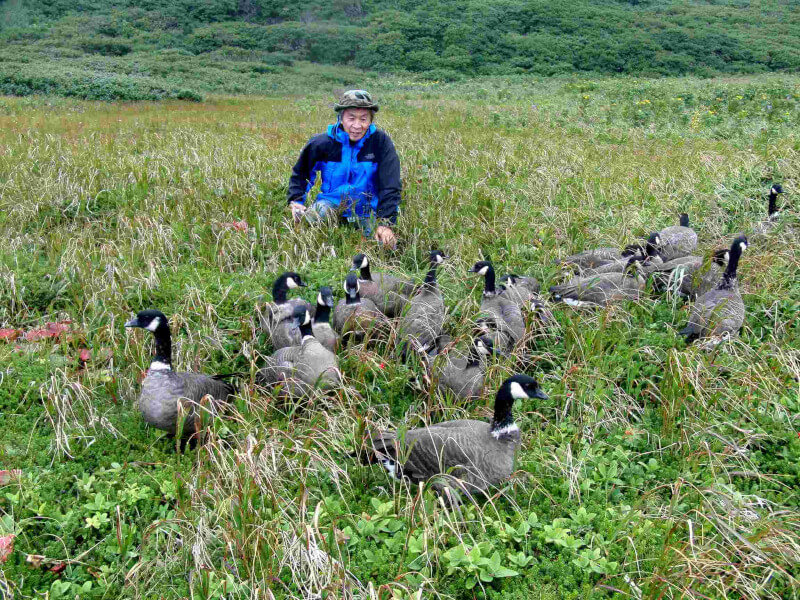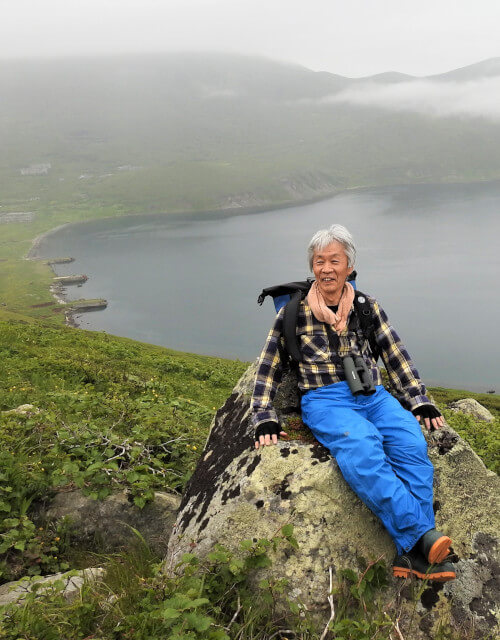
© Masayuki Kurechi
In this issue of Flyway story, we invited Mr. Masayuki Kurechi, Board Member of Ramsar Network Japan and Chair of EAAFP Anatidae Working Group, who has recently won the Eighth edition of the Ramsar Wetland Conservation Awards for his significant contributions to the long-term sustainable use of wetlands (link).
EAAFP: HelloMr. Kurechi, congratulations on winning the Eight Edition of the Ramsar Wetland Conservation Awards! We are thrilled to hear that one of our close partners has received this award and are excited to share your story with our audience. First of all, please tell us a little about yourself and your background. When or how did you get into the conservation field?
In 1971, when I was a university student majoring in physics, on the way to Izu-Numa marsh with my friend, I saw a flock of approximately one thousand White-fronted geese in a rice paddy for the first time. The place is now designated as a 2nd Ramsar Site in Japan in 1985.
When I move one step closer to the flock, the entire group of geese put their heads up on alert. And when I move another step towards them, suddenly they all took off to the sky. All of a sudden the whole sky was filled with sounds of geese flapping and crying. At that moment I fell in love with geese.
Since then, I started to get involved in geese surveys and conservation activities, of which the scientific ecology of the birds was still lacking at that time.
EAAFP: You led in drafting of the Resolution X.31 “Enhancing Biodiversity in Rice Paddies as Wetland Systems” at the Ramsar Convention CoP 10 held in Ro Korea in 2008. Please share with us the reason and the behind-the-scenes work that you put the Resolution forward.
If you wish to save geese, it is indispensable to conserve rice paddies, which are their main feeding grounds.
But on the other hand, many farmers who privately own rice paddies, consider geese pests. Thus, we needed to find a way for both farmers and geese to co-exist in harmony.
It was a challenging issue, but fortunately, it was solved by the Winter-flooded Rice Paddy Initiatives developed at the surrounding rice-paddies of Kabukuri-Numa Marsh, a Ramsar site listed in 2005.
At the same time, I thought out the way to present the potential of rich biodiversity which the traditional Asian rice-paddies have, especially to western Countries, which do not have rice culture in their historical background.
At the Ramsar COP10 held in Ro Korea in 2008, Resolution X.31 was adopted as a typical Asian resolution, in cooperation with Japanese and Korean NGOs and Governments.
At the CBD COP10 which was held in Nagoya-Japan two years after the Ramsar COP10, NGOs lobbied to Japanese Government resulting in the adoption of a Decision (X.34) equivalent to Ramsar Resolution X.31.
As a result, we were able to present the importance of biodiversity in rice paddies to the international society, which also brought out the local “winter flooded rice paddy” activities in Japan.
EAAFP: Following the previous question on the Resolution, do you have any insight on the future direction for sustainable wetland practices in the EAA Flyway? Are there areas you believe need further studies, implementation, or investment?
Many rice paddies, which are one of the most important habitats for migratory waterbirds, are involved in a range covered by EAAFP. Among these rice paddies, some are managed environment-friendlily, but many others are still depending on lots of agricultural chemicals.
We need to raise awareness of these conventional farmers positively to show that making use of wetland functions of rice paddies can benefit not only waterbirds but also farmers themselves.
GPS data showing migrating routes of waterbirds depending on rice paddies, and with joint research of living things in rice paddies could visualize the rich biodiversity, these are useful tools for raising awareness.

© Masayuki Kurechi
EAAFP: You have had an extensive career of over 40 years committed to supporting the conservation of migratory birds, and restoring multiple endangered species, What has been the greatest moment in your conservation career so far?
Most of the migratory waterbirds are needed to be conserved. There are a considerable number of problems which seem difficult or almost impossible to be solved.
The greatest moment for me was when I could solve a problem that seems impossible to be solved. Through leading in activities with continuous passion, and getting many supporters from domestic and oversea. In particular, some farmers who were originally formidable enemies became powerful supporters and shared the same goal. And watching a big flock of Aleutian Cackling Geese and Lesser Snow Geese restored from extinction by support from oversea fellows, and these people were bonded firmly. These are typical examples.
EAAFP: On top of being a Board member of Ramsar Network Japan, you are also the chair of the EAAFP Anatidae Working Group. As the chair of the EAAFP Anatidae Working group, may we ask if you have any visions for the group?
Extensive surveys using GPS transmitters etc. have recently been conducted, and as a result, previously unknown migration routes, breeding sites, and important habitats (hot spots) of Anatidae have been revealed. Anatidae Working Group is going to utilize the information on these surveys for conservation and management at the population level of these species.
EAAFP: Is there any recent conservation work that you would like to share with us? Or, are there any conservation projects you plan on working on?
Construction of many wind farms is ongoing in many places including ranges of EAA Flyway. EAAFP should organize a wind farm information center that manages information on wind farms including data about the impact on migratory birds, GPS data and local information on wind farms by local NGOs.
New monitoring systems, using SNS (message, photo, video) and inviting citizens along the flyway have been organized to trace migrating geese among connecting two EAAF sites, Kejyonuma/Kabukurinuma/ Izunuma, Miyagi and Hachirougata Kantakuchi, Akita handing over real-time information through SNS. That should be an activity to link two sites.
EAAFP: We learned that you are supportive to young people joining the conservation field, would you give a piece of advice to the youth?
Wild geese, a type of migratory waterbirds, are very attractive creatures. Every winter they migrate from the northern breeding grounds some thousand km away. Although recent studies revealed a lot about their migration routes, there are still many mysterious matters and unexpected movements. Through these observations, you can imagine their home some thousand km far away.
If you can work for these lovely birds, you can save or restore endangered species such as Aleutian Cackling Goose and Lesser Snow Goose.
Watch these attractive birds carefully and head for your future with these birds.

© Masayuki Kurechi




